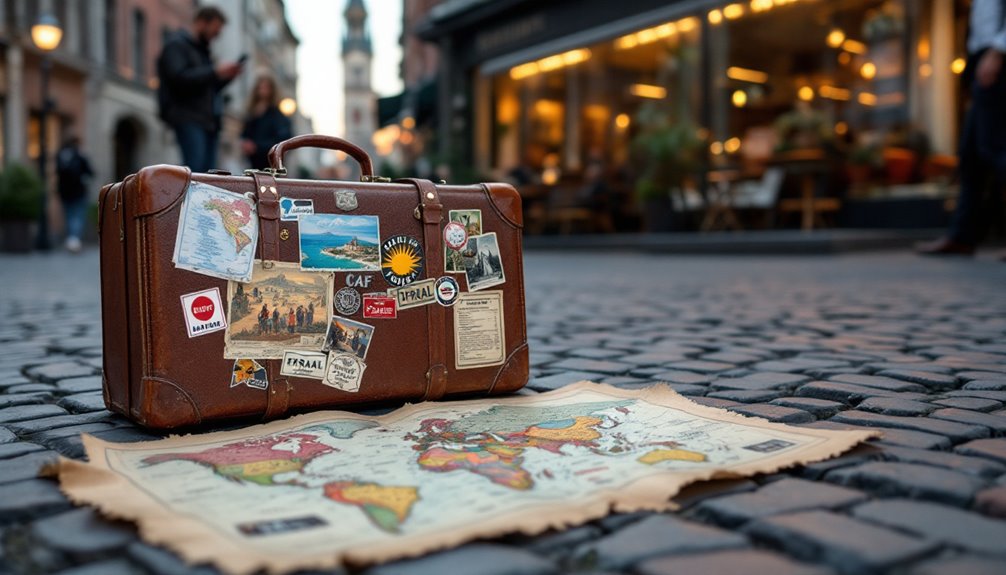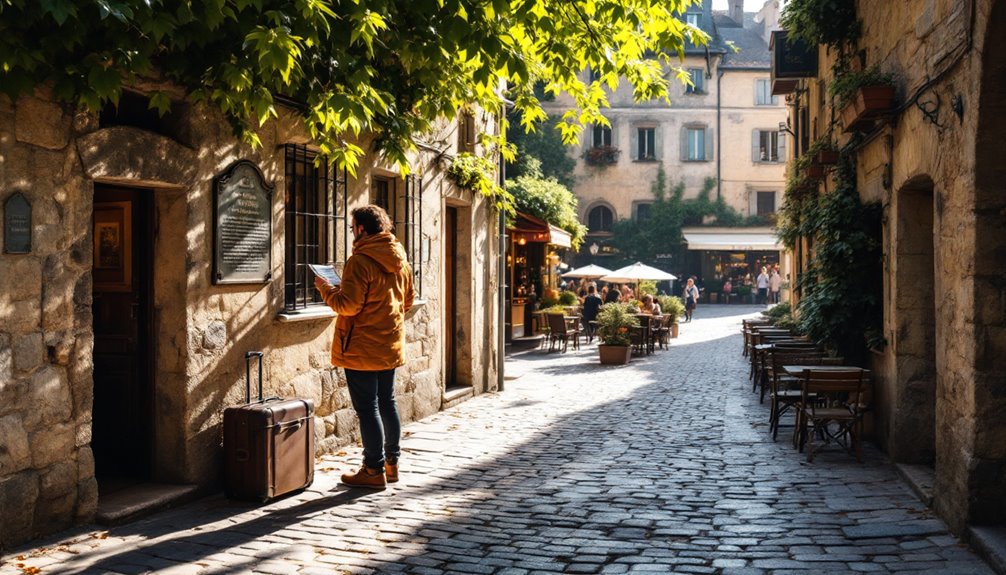When you approach writing about historical travel, it's essential to weave the past into the present seamlessly. You'll want to explore how significant locations once shaped events, while also making those stories resonate with today's audience. By using vivid details and personal connections, you'll highlight the emotional weight of history. But how do you strike that delicate balance between engaging storytelling and informative context? Understanding this can transform your narrative, making it not just informative, but genuinely compelling. The next steps will guide you through this intricate process.
Setting the Context
When you begin on writing about historical travel, it's essential to set the context by submerging into the time period of your narrative. You want to grab your readers and take them on a journey, so conduct your research! Start by identifying the historical era where your travel takes place. Gather information from primary and secondary sources, like diaries or letters, and absorb documentaries and films to really plunge into the time period.
Next, delve into specifics—research the technology, language, customs, and real locations relevant to your story. Understanding the geographical landscape and climate will help you create authentic, immersive settings. Visualize the sights and sounds of a bustling market or the smell of fresh bread wafting through the air; these details can bring your narrative to life! Authentic settings are achieved through extensive research, which emphasizes the importance of understanding daily life and cultural elements.
While you're at it, don't forget to reflect on the broader historical context. Significant events and cultural norms shape the atmosphere, so ensure you weave these elements into your narrative. By focusing on historical accuracy and using vivid details, you'll help your readers feel as if they're experiencing the past firsthand. Happy writing!
Incorporating Historical Details
Incorporating historical details into your travel narrative can transform a simple journey into a rich cloth of the past. When you select relevant historical information, think about your audience and the article's focus. You want details that illuminate the present and avoid anything that feels unclear or uninteresting. Historical anecdotes can add depth, making your narrative more engaging.
As you integrate history, consider using anniversaries or significant dates as anchors for your storytelling. Weave in concise anecdotes that keep your writing fluid and relatable—no one wants to feel like they're in a history lecture! Local perspectives can also provide unique insights, blending personal reflections with historical facts. Remember that a unique story or history lies at the heart of every destination, enhancing the reader's experience.
For accuracy, rely on primary and secondary sources, like diaries or newspaper editorials, ensuring they reflect the concerns of their time. Remember to treat historical subjects with respect and avoid presentism. Maintain chronological order to keep your narrative coherent. By using these narrative techniques, you'll create a lively cloth of the past that resonates with readers, making your travel experiences not just a journey through space but through time. So, go ahead—make history come alive!
Balancing History and Present

Striking the right balance between history and the present can elevate your travel writing from ordinary to extraordinary. To achieve this, start by understanding your audience's interests. Are they history buffs keen for every scrap of historical significance, or modern-day travelers seeking engaging experiences? Tailor your writing to meet their expectations, ensuring historical details enhance the current travel experience rather than overshadow it.
Integrate historical context seamlessly, connecting past events to today's reality. Use vivid language to paint a picture of both the historical and modern scenes. For instance, if you're describing an archaeological site, don't just mention its ancient origins—share how it shapes the local culture today. Including references to culinary experiences from both eras can enrich your narrative, illustrating how history influences contemporary life.
Avoid overwhelming readers with dense historical facts; instead, sprinkle in anecdotes or references to significant anniversaries that spark curiosity. Keeping your historical insights concise and engaging allows readers to appreciate the depth of your narrative without getting lost in time-warp.
Ultimately, the goal is to create a balanced narrative that informs and entertains, highlighting the modern relevance of history while grounding your readers firmly in the present. Remember, a well-told story can transform any travel experience into an unforgettable journey.
Engaging the Reader
Engaging your reader requires more than just recounting your travels; it's about weaving a narrative that captivates and connects. You want to adopt immersive storytelling by crafting a story with a clear beginning, middle, and end. Introduce characters you meet along the way; their quirks and stories add authenticity and depth. Maybe you encountered a local artist who shared tales of the town's history, or a guide with a knack for puns, making your journey memorable.
Conflict and resolution can inject suspense into your narrative, keeping readers on the edge of their seats. Perhaps you faced a challenge, like getting lost in a maze of ancient streets, only to find a hidden gem that changed your perspective. Flashbacks are great for providing context, giving your readers a glimpse into the rich history behind the places you visit.
Don't forget sensory details! Evocative descriptions of sights, sounds, and smells transport your audience, making them feel as if they're right there with you. By blending character development with vivid imagery, you create a story that resonates, allowing readers to connect with both the past and the present on a personal level. Engaging the reader requires immersive storytelling to fully draw them into your experience.
Structuring the Narrative

Creating a compelling travel narrative involves more than just enchanting storytelling; it requires a solid structure that guides your readers through the journey. You'll want to define a narrative frame that reflects the origins of your subject and the evolution of its story. Decide if your narrative should travel geographically, chronologically, or thematically. Thematic storytelling can be particularly effective, as seen in works like Roger Deakin's *Waterlog*.
Next, identify distinct narrative strands—your personal journey, historical accounts, and socio-historical impacts. Integrate these threads coherently, ensuring that each element remains readable and contributes meaningfully to the overall story arc. Maintaining historical accuracy is essential in enriching your narrative with layers of depth and credibility. Avoid relying on a simple plot; instead, focus on the events and actions that enrich your narrative.
Maintaining Clarity and Engagement
To captivate your readers, you need to weave clarity and engagement seamlessly into your narrative. Start by using clarity techniques, like incorporating sensory details that evoke sight, sound, taste, and touch. When you describe historical sites, make your readers feel like they're walking through time. Instead of overwhelming them with dry facts, paint colorful scenes that blend the past with the present.
Engagement strategies are just as essential. Open with a snappy anecdote or a vivid description that hooks interest. Share your own experiences, allowing readers to connect with you and your journey. Sprinkle in amusing historical anecdotes to keep the tone light and entertaining. Remember, a little humor can make even the most bizarre historical episodes enjoyable. The concept of independence of perspective reminds us that personal biases can shape how history is presented, adding another layer to your storytelling.
As you integrate historical context, tie it to present-day relevance. Show how past events shaped today's world, grounding your readers in time and place. And don't shy away from significant anniversaries to add depth to your narrative. By balancing clarity with engaging storytelling, you'll keep your readers absorbed and enthusiastic to explore history through your eyes. Ultimately, clarity and engagement make your travel writing not just informative, but an adventure in itself.
Wrapping up
So, while you explore historical travel, remember to weave the threads of the past into the fabric of the present. Picture standing where ancient battles raged while sipping modern coffee, or wandering through ruins that echo with stories of lives once lived. It's all about connecting the dots between then and now, making history relatable and fun. After all, history isn't just a series of dusty dates; it's the lively backdrop of our everyday lives. Happy travels!